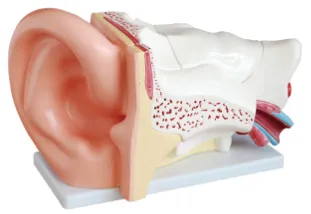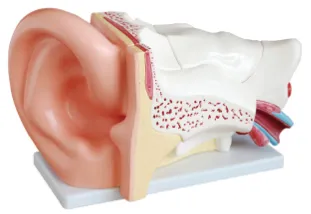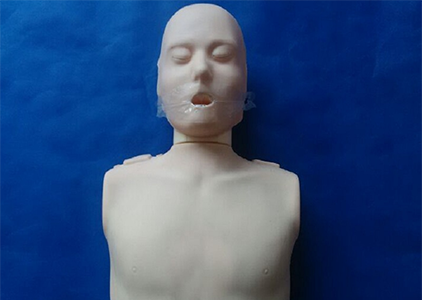
The anatomical model of the large ear plays an important role in helping students understand the mechanism of hearing by visually demonstrating the complex structure and function of the human ear and providing a platform for learners to gain an in-depth understanding of the hearing process. Here's how the big-ear anatomical model can help students understand specific aspects of hearing mechanisms:

1. Show the anatomical structure
The anatomical model of the large ear shows the external morphology and internal structure of the human ear in a highly simulated manner, including key components such as the outer ear (auricle and external auditory canal), the middle ear (tympanic membrane, auditory ossicles, and eustachian canals), and the inner ear (cochlea, vestibular, and semicircular canals). This intuitive display helps students to establish the overall cognition of the structure of the human ear and lays a foundation for the subsequent learning of the auditory mechanism.
2. Explain the sound conduction process
Through its detailed structural design, the model can clearly show the whole process of sound passing from the external environment to the human ear and being converted into neural signals. For example, the outer ear collects sound and carries it into the outer ear canal, while the tympanic membrane and auditory ossicles of the middle ear convert acoustic vibrations into mechanical energy and transmit them to the inner ear. The cochlea in the inner ear further converts mechanical energy into bioelectricity, generating nerve impulses that are sent to the brain for interpretation. This process is vividly reproduced on the model, helping students understand the complexity and precision of sound conduction.
Third, reveal the auditory sensory mechanism
The anatomical model of the large ear also reveals the microscopic mechanism of auditory perception. In the inner ear section, models typically show structures such as Corti organs (auditory receptors) within the cochlea, which are highly sensitive to the frequency and intensity of sound. Through the demonstration of the model and the teacher's explanation, students can learn how sounds are converted into neural signals and perceived by the brain.
Fourth, promote practical operation and interaction
In addition to static display, some big-ear anatomical models also have interactive functions, such as disassembly and rotation. These features enable students to manipulate the model by hand and explore in depth the various parts of the human ear and their interrelationships. This practice not only deepens students' understanding of hearing mechanism, but also cultivates their hands-on ability and the spirit of scientific inquiry.
To sum up, the anatomical model of the big ear effectively helps students understand the auditory mechanism by visually displaying the anatomical structure of the human ear, explaining the sound conduction process, revealing the auditory sensory mechanism, and promoting practical operation and interaction. This teaching method not only improves students' learning interest and enthusiasm, but also lays a solid foundation for their future medical study and clinical practice.







Sophie Asveld
February 14, 2019
Email is a crucial channel in any marketing mix, and never has this been truer than for today’s entrepreneur. Curious what to say.
Sophie Asveld
February 14, 2019
Email is a crucial channel in any marketing mix, and never has this been truer than for today’s entrepreneur. Curious what to say.